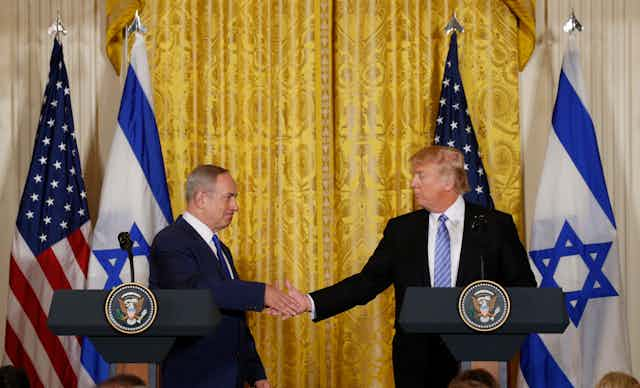President Donald Trump has effectively abandoned long-standing US policy on how to resolve the Israeli-Palestinian dispute. Appearing alongside visiting Israeli Prime Minister Benjamin Netanyahu last week, Trump said:
Looking at two-state or one-state [solutions], I like the one that both parties like. I’m very happy with the one both parties like. I can live with either one.
Trump’s statement caused grave concern, particularly for Palestinians. In leaving open the option of a single-state solution, Trump broke with two decades of international diplomacy.
The intent and meaning of Trump’s statement ought to be of great interest to Australians this week. Netanyahu’s four-day visit marks the first time a sitting Israeli prime minister has visited Australia.
Australia’s prime minister, Malcolm Turnbull, this week rejected the orthodox position that Israel is in violation of international law in Palestine. He condemned “one-sided” UN Security Council resolutions criticising Israel, and celebrated Netanyahu’s visit.
Turnbull’s repetition of Australia’s commitment to a two-state solution appears hollow in light of his government’s uncritical welcome of Netanyahu. Turnbull hardly appears to be a leader who will force Netanyahu back to the negotiating table.
But what would single and two-state solutions look like?
What is a one-state solution?
A one-state solution would mean the establishment of a single state comprising all the territory of Israel and Palestine. This would necessarily include all of both populations, which would mean the end of a Jewish majority.
Author Antony Loewenstein has previously argued for a single state based on principles of equality and democracy. He concluded that Zionism has succeeded in effectively conquering Palestinian territory. In doing so, it has made a two-state solution unworkable.
In a more pragmatic argument, academic Padraig O'Malley has claimed that the Israeli army could not be relied on to enforce the closure of Israeli settlements in Palestine if a two-state solution was agreed. His research found the proportion of Orthodox Jewish soldiers was increasing, and that the army is increasingly Zionist in ideology.
This view points to a darker vision of a one-state solution than what Loewenstein describes. This is a view of an expansionist Israel that continues to annex Palestinian territory to the point where it would be logistically impossible to establish an independent Palestinian state.
Such a solution would effectively be an apartheid state. Its foundation would be in the colonisation of Palestine and the denial of equal rights for Palestinian people.
There is some support in the Israeli political establishment for such an approach. Certain members of Israel’s governing Likud party are reportedly motivated by a belief that:
God gave the West Bank to the Jewish people.
The leader of The Jewish Home party, Naftali Bennett, proposed a one-state “solution” in 2014. Bennett argued that regional security risks and the decline of the nation-state meant the responsible option was for Israel to permit Palestinian “autonomy” in some areas, while “applying Israeli law and asserting national sovereignty” in settlements that will formally annex land.
Commentators both inside Israel and outside it have argued that an apartheid state already exists. According to the 1973 Apartheid Convention, apartheid includes acts:
… committed for the purpose of establishing and maintaining domination by one racial group of persons over any other racial group of persons and systematically oppressing them.
The vast weight of findings by international courts, organisations and human rights monitors in Palestinian territory identify such acts as features of the 50-year-long Israeli occupation. Israel’s continuing construction of a “security barrier” through the West Bank, and accompanying settlement construction on Palestinian territory, bolsters the apartheid label.
It is hard to fathom how a single-state solution could overcome the entrenched inequality between occupying power and colonised people.
What about a two-state solution?
Despite Trump’s seemingly spontaneous concession last week, the two-state solution remains the main game of international diplomacy. It is undoubtedly the demand of most Palestinian people.
At its core, the two-state solution aims to establish a Palestinian state that would be independent from Israel and act as a peaceful neighbour. This would require an end to Israel’s occupation of Palestinian territory, which has long been condemned internationally as a violation of the prohibition on the acquisition of territory by force.
Israel is loath to move further toward a two-state solution. It demands first that Palestinians acknowledge Israel’s right to exist, and end terrorist attacks on Israeli targets.
The two sides are also far apart on possible borders for a two-state solution. Palestine would want to claim all the land Israel seized from Jordan in the 1967 Six-Day War. Meanwhile, Israel claims more and more land through annexation via construction of the West Bank barrier and growing settlements.
The weight of international law and practice is with the Palestinians here. In 2012, a majority vote of the UN General Assembly granted Palestine non-member observer state status. While this move did not guarantee Palestinian independence, Palestinian Authority President Mahmoud Abbas described it as a “birth certificate” for a state.
But the weight of international diplomacy is far harder to pin down. Trump’s recent break with established policy further complicates a conflict too heavily influenced by US patronage of Israel.

